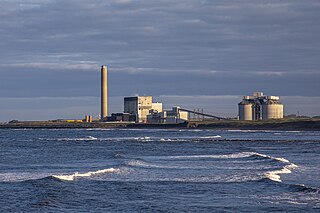
Drax power station is a large biomass power station in Drax, North Yorkshire, England, capable of co-firing petroleum coke. It has a 2.6 GW capacity for biomass and 1.29 GW capacity for coal. Its name comes from the nearby village of Drax. It is situated on the River Ouse between Selby and Goole. Its generating capacity of 3,906 megawatts (MW) is the highest of any power station in the United Kingdom, providing about 6% of the United Kingdom's electricity supply.

Glanford Power Station is an electricity generating plant located on the Flixborough industrial estate near Scunthorpe in North Lincolnshire. It generates around 13.5 megawatts (MW) of electricity, which is enough to provide power to about 32,000 homes. It was designed to generate electricity by the burning of poultry litter, and was only the second of this kind of power station in the world to have been built when it went into operation in 1993. The station is owned by Energy Power Resources (EPR) and operated by its subsidiary Fibrogen.

Drax Group PLC is a power generation business. The principal downstream enterprises are based in the UK and include Drax Power Limited, which runs the biomass and coal fuelled Drax power station, near Selby in North Yorkshire. The Group also runs an international biomass supply chain business. The company is listed on the London Stock Exchange and is a constituent of the FTSE 250 Index.

As of 2018, renewable energy accounted for 79% of the domestically produced electricity used in Brazil.

Ghana generates electric power from hydropower, fossil-fuel, and renewable energy sources. Electricity generation is one of the key factors in order to achieve the development of the Ghanaian national economy, with aggressive and rapid industrialisation; Ghana's national electric energy consumption was 265 kilowatt hours per capita in 2009.
According to the International Hydropower Association, Canada is the fourth largest producer of hydroelectricity in the world in 2021 after the United States, Brazil, and China. In 2014, Canada consumed the equivalent of 85.7 megatonnes worth of oil of hydroelectricity, 9.8% of worldwide hydroelectric consumption. Furthermore, hydroelectricity accounted for 25.7% of Canada's total energy consumption. It is the third-most consumed energy in Canada behind oil and natural gas.

Lynemouth Power Station is a biomass power plant which provides electricity for the UK National Grid. Until March 2012, it was the main source of electricity for the nearby Alcan Lynemouth Aluminium Smelter. It is located on the coast of Northumberland, north east of the town of Ashington in north east England. The station has stood as a landmark on the Northumberland coast since it opened in 1972, and had been privately owned by aluminium company Rio Tinto Alcan throughout its operation until December 2013, when RWE npower took over. In January 2016 it was acquired by Energetický a průmyslový holding.

North Tees Power Station refers to a series of three coal-fired power stations on the River Tees at Billingham in County Durham. Overall, they operated from 1921 until 1983, and the C station, the last on the site, was demolished in 1987. Billingham Biomass Power Station is to be built on their site.

The North Blyth Biomass Project was a proposed biomass-fired power station planned to be located at North Blyth, Northumberland on the north bank of the River Blyth near its tidal estuary. When commissioned it would have had a generating capacity of 100 megawatts, enough electricity to provide for 170,000 homes. Renewable Energy Systems, the station's developer, was granted government consent on 24 July 2013 to build the £250m project.
Tees Renewable Energy Plant is a proposed biomass fueled power station situated on the River Tees at Teesport in Redcar and Cleveland, North East England. The plant will operate alongside other renewable energy units and industrial processes operating in the Northeast of England Process Industry Cluster (NEPIC)
The Davidson County Solar Farm is a 17.2 megawatt solar power station located in the heart of North Carolina, near the community of Linwood. SunEdison built the array of photovoltaic panels, and Duke Energy buys all the output from the solar farm. The solar farm is located on North Carolina Highway 47, off New Jersey Church Road.

As of 2019, renewable energy in Morocco covered 35% of the country’s electricity needs.

BEI-Teesside is a planned biomass power station, expected to be built on the River Tees at Port Clarence.

Renewable energy in Russia mainly consists of hydroelectric energy. In 2010, the country was the sixth largest producer of renewable energy in the world, although it was 56th when hydroelectric energy was not taken into account. Some 179 TWh of Russia's energy production came from renewable energy sources, out of a total economically feasible potential of 1823 TWh. 16% of Russia's electricity was generated from hydropower, and less than 1% was generated from all other renewable energy sources combined. Roughly 68% of Russia's electricity was generated from thermal power and 16% from nuclear power.

Ethiopia generates most of its electricity from renewable energy, mainly hydropower.
Denmark is a leading country in wind energy production and wind turbine production. Wind power alone produced 47% of Denmark's electricity consumption in 2017, and is expected to increase its production by nearly 80% in the years to 2024.
There is enormous potential for renewable energy in Kazakhstan, particularly from wind and small hydropower plants. The Republic of Kazakhstan has the potential to generate 10 times as much power as it currently needs from wind energy alone. But renewable energy accounts for just 0.6 percent of all power installations. Of that, 95 percent comes from small hydropower projects. The main barriers to investment in renewable energy are relatively high financing costs and an absence of uniform feed-in tariffs for electricity from renewable sources. The amount and duration of renewable energy feed-in tariffs are separately evaluated for each project, based on feasibility studies and project-specific generation costs. Power from wind, solar, biomass and water up to 35 MW, plus geothermal sources, are eligible for the tariff and transmission companies are required to purchase the energy of renewable energy producers. An amendment that introduces and clarifies technology-specific tariffs is now being prepared. It is expected to be adopted by Parliament by the end of 2014. In addition, the World Bank's Ease of Doing Business indicator shows the country to be relatively investor-friendly, ranking it in 10th position for investor protection.

Renewable energy in South Africa is energy generated in South Africa from renewable resources, those that naturally replenish themselves—such as sunlight, wind, tides, waves, rain, biomass, and geothermal heat. Renewable energy focuses on four core areas: electricity generation, air and water heating/cooling, transportation, and rural energy services. The energy sector in South Africa is an important component of global energy regimes due to the country's innovation and advances in renewable energy. South Africa's greenhouse gas (GHG) emissions is ranked as moderate and its per capita emission rate is higher than the global average. Energy demand within the country is expected to rise steadily and double by 2025.
Vietnam utilizes four main sources of renewable energy: hydroelectricity, wind power, solar power and biomass. By the end of 2018, hydropower was the largest source of renewable energy, contributing about 40% to the total national electricity capacity. In 2020, wind and solar had a combined share of 10% of the country's electrical generation, already meeting the government's 2030 goal, suggesting future displacement of growth of coal capacity. By the end of 2020, the total installed capacity of solar and wind power had reached over 17 GW. Over 25% of total power capacity is from variable renewable energy sources. The commercial biomass electricity generation is currently slow and limited to valorizing bagasse only, but the stream of forest products, agricultural and municipal waste is increasing. The government is studying a renewable portfolio standard that could promote this energy source.
Burning of charcoal and wood fuel provides approximately 94 percent of the energy in Malawi. Much of the renewable hydroelectric potential of the country is untapped. As per 2018 Population and Housing Census, the national electrification rate in Malawi was 10%, with 37% of the urban population and only 2% of the rural population having access to electricity.














